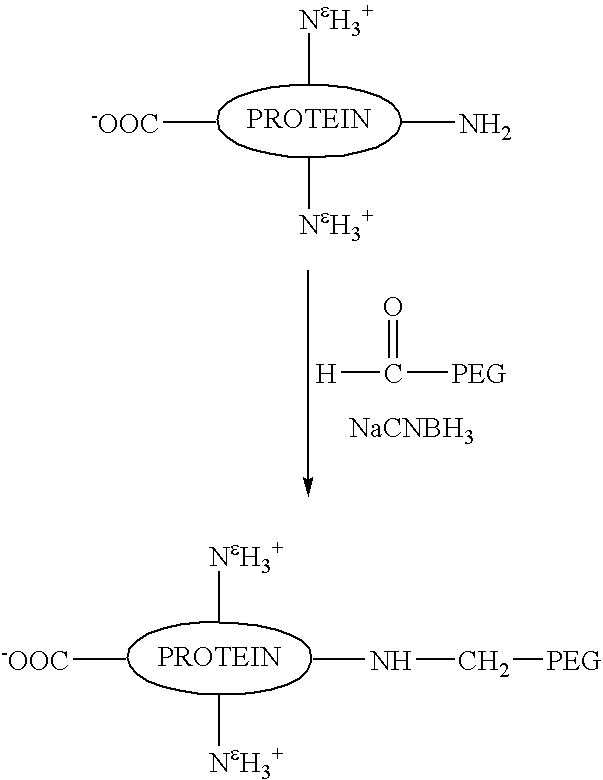N-terminally chemically modified protein compositions and methods
a chemical modification and protein technology, applied in the field of protein modification, can solve the problems of affecting the quality of protein components,
- Summary
- Abstract
- Description
- Claims
- Application Information
AI Technical Summary
Benefits of technology
Problems solved by technology
Method used
Image
Examples
example 1
A. Preparation of Recombinant Human met-G-CSF
[0066]Recombinant human met-G-CSF (referred to as “rhG-CSF” or “r-met-hu-G-CSF” from time to time herein) was prepared as described above according to methods in the Souza patent, U.S. Pat. No. 4,810,643, which is herein incorporated by reference. The rhG-CSF employed was an E. coli derived recombinant expression product having the amino acid sequence (encoded by the DNA sequence) shown below (Seq.ID NOs. 1 and 2):
[0067]
ATG ACT CCA TTA GGT CCT GCT TCT TCT CTG CCG CAA M T P L G P A S S L P QAGC TTT CTG CTG AAA TGT CTG GAA CAG GTT CGT AAA S F L L K C L E Q V R KATC CAG GGT GAC GGT GCT GCA CTG CAA GAA AAA CTG I Q G D G A A L Q E K LTGC GCT ACT TAC AAA CTG TGC CAT CCG GAA GAG CTG C A T Y K L C H P E E LGTA CTG CTG GGT CAT TCT CTT GGG ATC CCG TGG GCT V L L G H S L G I P W ACCG CTG TCT TCT TGT CCA TCT CAA GCT CTT CAG CTG P L S S ...
example 2
[0086]This example demonstrates a method of preparing a substantially homogenous population of monopegylated G-CSF using reductive alkylation, and characterization of this population. Recombinant G-CSF as described in the above example was used. As can be seen, not only do the present methods provide advantages in terms of yield of N-terminally chemically modified material, but also, the amine linkages of the present reductive alkylation process produce substantially more stable products as demonstrated by a large difference in the degree of aggregation upon storage.
A. Preparation of the Mono-methoxypolyethylene Glycol-GCSF Conjugates with the Site of Attachment at the N-terminal α-amino Residue.
[0087]To a cooled (4° C.),stirred solution of rhG-CSF (1 ml, 5 mg / ml as described in the Example above) in 100 mM sodium phosphate, pH 5, containing 20 mM NaCNBH3, was added a 5-fold molar excess of methoxypolyethylene glycol aldehyde (MPEG)(average molecular weight, 6 kDa). The stirring of ...
example 3
[0108]This example demonstrates chemically modified consensus interferon. More specifically, this example demonstrates a method of preparing a substantially homogenous population of monopegylated IFN-con1, and characterization of this population.
[0109]It should be noted that while the present example uses IFN-con1, any of the consensus interferons as set forth above may be chemically modified. Such chemical modification may be with any of the water soluble polymers as listed above, although PEG is used here. For pegylation, PEG 12000 is used here, although any water soluble PEG species may be used (PEG 12000 was selected for ease in handling and convenience). Again, a variety of means for chemical modification are available (such as acetylation) but, for selective N-terminal chemical modification, such as N-terminal pegylation, the present reductive alkylation method as described in this example is preferred.
A. Preparation of Consensus Interferon
[0110]IFN-αcon1 (here referred to as ...
PUM
| Property | Measurement | Unit |
|---|---|---|
| molecular weight | aaaaa | aaaaa |
| molecular weight | aaaaa | aaaaa |
| molecular weight | aaaaa | aaaaa |
Abstract
Description
Claims
Application Information
 Login to View More
Login to View More - R&D
- Intellectual Property
- Life Sciences
- Materials
- Tech Scout
- Unparalleled Data Quality
- Higher Quality Content
- 60% Fewer Hallucinations
Browse by: Latest US Patents, China's latest patents, Technical Efficacy Thesaurus, Application Domain, Technology Topic, Popular Technical Reports.
© 2025 PatSnap. All rights reserved.Legal|Privacy policy|Modern Slavery Act Transparency Statement|Sitemap|About US| Contact US: help@patsnap.com



